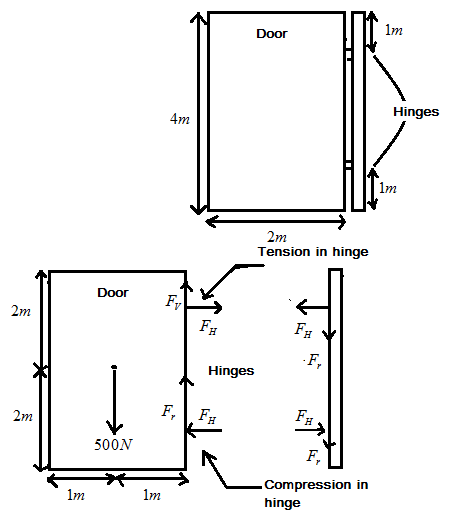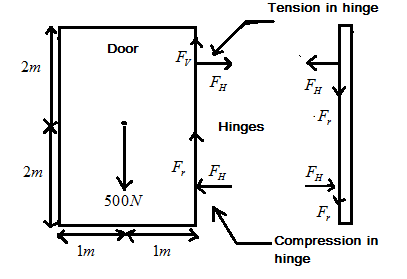
The door of an almirah is $ 4m $ high, $ 1m $ wide and weighs $ 50kg $ . The door is supported by two hinges situated at a distance of $ 1m $ from the ends. If the magnitude of each force exerted by the hinges on the door is equal, find this magnitude.


Answer
515.1k+ views
Hint :Here, you are given a door of an almirah which is held vertically with the help of two hinges as supports. It is also given to you that the magnitude of each force exerted by the hinges on the door are equal. You are asked to find these forces exerted by the hinge. What you need to do is first draw the free body diagram of the forces that are acting on the door. To analyze the forces on the door and to get the values of them, you need to apply Newton’s law of motion and also, find torque if required.
Complete Step By Step Answer:

The free body diagram is made here. We denote the upper hinge as hinge 1 and the lower hinge as hinge 2.
The forces that will be applied by the hinge 1 are as follows:
(1) a force of magnitude $ {F_V} = {F_1} $ acting vertically upward
(2) a force of magnitude $ {F_H} = {R_1} $ acting towards the right.
The forces that will be applied by the hinge 2 are as follows:
(1) a force of magnitude $ {F_V} = {F_2} $ acting vertically upward
(2) a force of magnitude $ {F_H} = {R_2} $ acting towards the left.
Now, the door is obviously supposed to be in equilibrium and therefore the net force on the door is equal to zero. So, we have sum of vertical and sum of horizontal forces equal to zero. Let us write them in the form of equations.
$
{F_1} + {F_2} - \left( {50} \right)\left( {10} \right) = 0 \\
{F_1} + {F_2} = 500 \\
$
$
{R_1} - {R_2} = 0 \\
{R_1} = {R_2} \\
$
It is given to you that the magnitude of the force applied by the hinges are equal and therefore, we have,
$
\sqrt {{F_1}^2 + {R_1}^2} = \sqrt {{F_2}^2 + {R_2}^2} \\
{F_1}^2 + {R_1}^2 = {F_2}^2 + {R_2}^2 \\
{F_1}^2 + {R_1}^2 = {F_2}^2 + {R_1}^2 \\
\therefore {F_1}^2 = {F_2}^2 \\
{F_1} = {F_2} \\
$
So, we get.
$
{F_1} + {F_2} = 500 \\
{F_1} + {F_1} = 500 \\
{F_1} = {F_2} = 250N \\
$
Now, in order to get $ {R_1}\& {R_2} $ , we equate the torque about the hinge 2 to zero as the door does not rotate about that point with axis of rotation being perpendicular to the door, that is towards you. The door rotates only along the axis passing through both the hinges.
So, we get,
$
{\tau _{hinge - 2}} = \left( {{R_1}} \right)\left( 2 \right) - \left( {500} \right)\left( 1 \right) = 0 \\
\to {R_1} = 250N \\
$
As $ {R_1} = {R_2} $ , we get $ {R_2} = 250N $ .
Therefore, the resultant force applied by a hinge is given as $
{F_{hinge}} = \sqrt {{F_1}^2 + {R_1}^2} = \sqrt {{{\left( {250} \right)}^2} + {{\left( {250} \right)}^2}} = 250\sqrt 2 N \\
{F_{hinge}} = 353.55N \\
$
Hence, the magnitude of each force exerted by the hinges on the door is equal to $ 353.55N $ .
Note :
Here, we have used Newton’s second law of motion that the net force on the door is zero because the door is in equilibrium, meaning that the acceleration of the door is zero. Also, we used the torque about the hinge 2 in order to obtain the value of $ {R_1}\& {R_2} $ . So, you are supposed to keep in mind the approach we used to calculate the force applied by the hinges.
Complete Step By Step Answer:

The free body diagram is made here. We denote the upper hinge as hinge 1 and the lower hinge as hinge 2.
The forces that will be applied by the hinge 1 are as follows:
(1) a force of magnitude $ {F_V} = {F_1} $ acting vertically upward
(2) a force of magnitude $ {F_H} = {R_1} $ acting towards the right.
The forces that will be applied by the hinge 2 are as follows:
(1) a force of magnitude $ {F_V} = {F_2} $ acting vertically upward
(2) a force of magnitude $ {F_H} = {R_2} $ acting towards the left.
Now, the door is obviously supposed to be in equilibrium and therefore the net force on the door is equal to zero. So, we have sum of vertical and sum of horizontal forces equal to zero. Let us write them in the form of equations.
$
{F_1} + {F_2} - \left( {50} \right)\left( {10} \right) = 0 \\
{F_1} + {F_2} = 500 \\
$
$
{R_1} - {R_2} = 0 \\
{R_1} = {R_2} \\
$
It is given to you that the magnitude of the force applied by the hinges are equal and therefore, we have,
$
\sqrt {{F_1}^2 + {R_1}^2} = \sqrt {{F_2}^2 + {R_2}^2} \\
{F_1}^2 + {R_1}^2 = {F_2}^2 + {R_2}^2 \\
{F_1}^2 + {R_1}^2 = {F_2}^2 + {R_1}^2 \\
\therefore {F_1}^2 = {F_2}^2 \\
{F_1} = {F_2} \\
$
So, we get.
$
{F_1} + {F_2} = 500 \\
{F_1} + {F_1} = 500 \\
{F_1} = {F_2} = 250N \\
$
Now, in order to get $ {R_1}\& {R_2} $ , we equate the torque about the hinge 2 to zero as the door does not rotate about that point with axis of rotation being perpendicular to the door, that is towards you. The door rotates only along the axis passing through both the hinges.
So, we get,
$
{\tau _{hinge - 2}} = \left( {{R_1}} \right)\left( 2 \right) - \left( {500} \right)\left( 1 \right) = 0 \\
\to {R_1} = 250N \\
$
As $ {R_1} = {R_2} $ , we get $ {R_2} = 250N $ .
Therefore, the resultant force applied by a hinge is given as $
{F_{hinge}} = \sqrt {{F_1}^2 + {R_1}^2} = \sqrt {{{\left( {250} \right)}^2} + {{\left( {250} \right)}^2}} = 250\sqrt 2 N \\
{F_{hinge}} = 353.55N \\
$
Hence, the magnitude of each force exerted by the hinges on the door is equal to $ 353.55N $ .
Note :
Here, we have used Newton’s second law of motion that the net force on the door is zero because the door is in equilibrium, meaning that the acceleration of the door is zero. Also, we used the torque about the hinge 2 in order to obtain the value of $ {R_1}\& {R_2} $ . So, you are supposed to keep in mind the approach we used to calculate the force applied by the hinges.
Recently Updated Pages
Master Class 11 Economics: Engaging Questions & Answers for Success

Master Class 11 English: Engaging Questions & Answers for Success

Master Class 11 Social Science: Engaging Questions & Answers for Success

Master Class 11 Biology: Engaging Questions & Answers for Success

Class 11 Question and Answer - Your Ultimate Solutions Guide

Master Class 11 Business Studies: Engaging Questions & Answers for Success

Trending doubts
10 examples of friction in our daily life

One Metric ton is equal to kg A 10000 B 1000 C 100 class 11 physics CBSE

Difference Between Prokaryotic Cells and Eukaryotic Cells

1 Quintal is equal to a 110 kg b 10 kg c 100kg d 1000 class 11 physics CBSE

State the laws of reflection of light

Explain zero factorial class 11 maths CBSE




